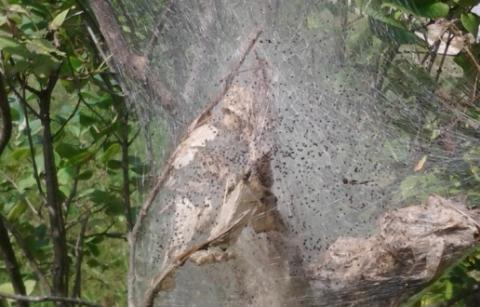How to deal with fall webworms

The signs of fall are all around us: shorter days, cooler temperatures, pumpkin-spiced foods and an abundance of silky nests in hardwood trees and shrubs.
That last sign is the often-unwelcomed indication that the fall webworm has arrived. The silky nests you see in wild cherry and fruit trees and some maples are the product of fall webworm larvae, which emerge in late summer and early autumn. The webs protect the larvae as they feast on the leaves. As they move on to new areas of the tree to eat, their nests grow larger.
Fall webworm is actually a moth. Once the larvae have gorged themselves on leaves, they crawl out of the tree, construct a cocoon and spend the winter as pupae in the soil. In the early summer, the adult moths emerge. In July, they lay their eggs, which hatch soon after. The new larvae start the cycle all over again by weaving silky nests.
If you spot fall webworm nests on your trees, don’t panic. Damage to trees should be minimal — most of the damage is done late in the growing season, when the leaves have already done most of their work and are preparing to fall off.
Healthy trees won’t succumb to the fall webworms’ feeding frenzy. The silky nests are unsightly, but otherwise, fall webworms are more of an aesthetic nuisance than a threat to the infested tree.
It isn’t necessary to spend much time dealing with these pests. Several pesticides on the market will control fall webworms, but the easiest way to cope with these hungry intruders is to prune out and destroy the nests. A stick or pole with a nail inserted crosswise can snag and lift the webs out of small trees. A well-aimed blast with the garden hose can also do the trick. Even better, you can treat yourself to a hot cup of coffee and let birds, insect predators and internal parasites keep fall webworms in check.

